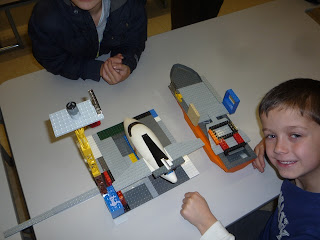What is your favorite hobby? Create a building or a space that would be ideal for you to do your hobby.
Your entry must have:
- At least one entrance.
- Room for you and some of your friends to do your hobby (if you are unsure of how much room you will need for a few of your friends, use your LEGO people as a guide)
Your entry will be judged on:
- Appearance
- Creativity
- Your overall idea
As the kids arrived, many started building their space immediately, making sure a great idea did not leave them before becoming actualized. Others brought custom pieces from home in an effort to express ideas they had been planning all week. Many of the spaces became a team effort, which is a crucial lesson that Jim & I overlooked; the idea that architecture is used by all in many situations, and hearing different perspectives brings multiple function requirements to the design.
 |
| An airport for UPS |
We gave the kids a little over an hour to create their space. As time was narrowing, you could see similarities between the cafeteria where the club meets and an architecture studio. Some individuals were fully prepared for the presentation ahead, whiles others struggled to get the ball rolling, and of course there are always the gamblers whipping something together at the last minute hoping a masterpiece is created in this fury of spontaneity.
 |
| A Restaurant |
 |
| Soccer Stadium |
When presentation time arrived there were several eager to explain their design. It was obvious that some had different priorities than others. As some of the children explained the function of every piece created, others expressed the “coolness” of the space and why blue LEGOs were used instead of red LEGOs because it’s their favorite color. As the evening came to a close I believe the kids had a good time overall. Each group was proud to receive a ribbon from the judging architects (Jim and myself), and psyched for the evening snack just ahead.
 |
| Glen Acres Lego Club w/ Nate & Jim |
After looking back, many principles of architectural design were experienced that evening, some consciously while other subconsciously. I’m certain there are more, but the obvious were teamwork, function, form, scale, time management, and most importantly, creativity.
-Nathan Houser

No comments:
Post a Comment